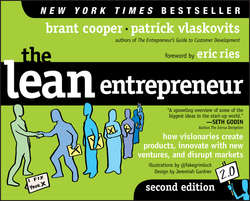Читать книгу The Lean Entrepreneur - Vlaskovits Patrick - Страница 6
На сайте Литреса книга снята с продажи.
Introduction
WHAT IS THE LEAN ENTREPRENEUR?
ОглавлениеIt’s hard to know where you live on the curve. As far as we can tell, the arrow of time moves in one direction. You can never step in the same river twice (Heraclitus), and all that.
Change isn’t constant. We change constantly, but at different rates, depending on where we are on the curve. Fast change comes in times of cheap experimentation. Massive new life emerged on Earth during time periods in which a convergence of foundational platforms, like the different aspects of Earth’s biosphere, favored the emergence of diverse species, most of which failed. Massive new technologies emerge when the discovery and extraction of massive amounts of resources (water, minerals, fuel) provide low-cost industrial experiments, most of which fail.
Although our narratives of the past reveal eras of big change, those who lived during those times likely didn’t see it that way:
“Hey bro, pretty cool, we’re living in the Age of Renaissance, yeah?”
“Beats the Middle Ages, dude.”
“Word.”
The life you live defines normalcy.
Is change big or little? Dramatic or incremental? Permanent or cyclical? Disruptive or sustaining?
No one can pinpoint where we exist on the curve. Is change over or just beginning? Are we at an inflection point? Up or down? Is the end nigh, or is the Age of Aquarius approaching?
A broken clock is right twice a day.
How can we know when we are amid big change? Listen to experts and incumbents. If you hear a lot of this, then be forewarned – “The times, they are a-changin’ ”:
● “Don’t worry, it’s just the business cycle; or, in other words, the next bus to pick us up will be by in five minutes.”
● “Will x be ubiquitous? Oh that’s ridiculous; x is exactly what is already consuming your market. ‘It’s just a normal cycle, we’ll be back.’ ”
● “Piracy is killing us!”
The Lean Entrepreneur is about navigating change.
Whether what’s emerging is considered the postindustrial age, an information society, or an experience economy, The Lean Entrepreneur aims to help you create products people want, innovate with new ventures, and disrupt markets. With big change comes big opportunity. We’ll provide you with grounded ways to market-test your ideas with the right market segment; we’ll give you real, tangible examples of how successful entrepreneurs are applying lean innovation principles; and we’ll get you started right now and get you up to speed quickly.
We think of The Lean Entrepreneur as a field guide because it is designed to be brought into the field, whether that is your office, the local co-working space, your client’s place of business, or the local coffee shop as you surf cyberspace, planning your conquest. Whereas a traditional naturalist field guide helps outdoorsmen identify the plants and animals of a certain geography, our field guide will help you identify concepts and ideas in the geography of innovation. At first blush, some of these ideas may not appear to be applicable to your business, but with an open mind and a spirit of creativity, we will demonstrate how these concepts can and will radically reshape how you bring products to market and, ultimately, success to your business.
The Lean Entrepreneur is a book of synthesis, of recombination, and, we hope, of inspiration. It is a synthesis in that we will show where several preexisting ideas about how to innovate, which initially appear to be virtual islands strewn across a sea, actually share connections and complement each other. And if we have done this well, a larger, more complete, and more comprehensive map of the changes coming and how to innovate now will have emerged for you.
As Henry Ford recombined existing technologies from different domains (interchangeable parts, the assembly line, the electric motor) into a wholly novel and disruptive set of innovations resulting in the manufacture and distribution of the first durable, mass-market automobile, we hope to inspire vis-à-vis our interpretations of several big ideas, which will result in a new approach that scales well for disruptive innovators and entrepreneurs – from small, value-producing businesses to the Fortune 500.
The product development methodologies and innovation frameworks espoused by The Lean Entrepreneur are heavily influenced by truly big thinkers, such as Steve Blank and Eric Ries, creators of Customer Development and The Lean Startup, respectively. However, other, rather similar, innovation methodologies such as design thinking and discovery-driven planning also exist.
All the aforementioned frameworks tend to be driven by principle rather than by a set of cut-and-dried tactics, and are typified by iterative, customer-centric, data-informed approaches resembling the scientific method; and we, as natural-born bricoleurs, happily borrow from ideas that we deem appropriate as well as discard or ignore what we deem unhelpful.
We urge you, the reader, to do the same with ideas and approaches presented in this book.
